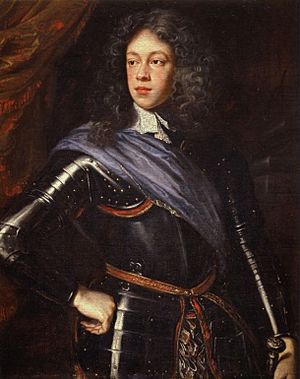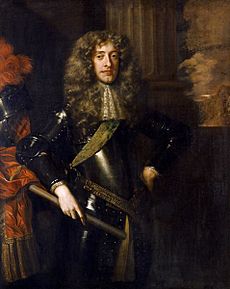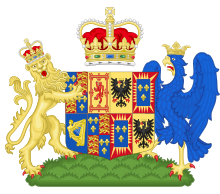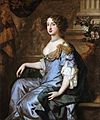Mary of Modena facts for kids
Quick facts for kids Mary of Modena |
|||||
|---|---|---|---|---|---|

Portrait from the studio of Willem Wissing, painted sometime between 1676 and 1685
|
|||||
| Queen consort of England, Scotland and Ireland | |||||
| Tenure | 6 February 1685 – 11 December 1688 | ||||
| Coronation | 23 April 1685 | ||||
| Born | 5 October 1658 Ducal Palace, Modena, Duchy of Modena and Reggio |
||||
| Died | 7 May 1718 (aged 59) Château de Saint-Germain-en-Laye, Paris, France |
||||
| Burial | Convent of the Visitations, Chaillot, France | ||||
| Spouse | |||||
| Issue among others |
|||||
|
|||||
| House | Este | ||||
| Father | Alfonso IV, Duke of Modena | ||||
| Mother | Laura Martinozzi | ||||
| Religion | Roman Catholicism | ||||
Mary of Modena (Italian: Maria Beatrice Eleonora Anna Margherita Isabella d'Este; 5 October 1658 – 7 May 1718) was the Queen of England, Scotland, and Ireland. She was the second wife of King James II and VII. Mary was a devoted Roman Catholic.
She married James, who was the younger brother and next in line to King Charles II. Mary cared deeply for her husband and children. Two of her children lived to be adults: James Francis Edward and Louisa Maria Teresa.
Mary was born a princess in the Duchy of Modena in Italy. She is best known for the birth of her only surviving son, James Francis Edward. There were rumors that he was secretly brought into the birth room. People thought this was to keep her husband's Catholic family in power.
James Francis Edward's birth helped cause the "Glorious Revolution". This event removed James II and VII from power. His Protestant daughter, Mary II, took his place. Mary II was from James's first marriage to Anne Hyde. Mary II and her husband, William III of Orange, ruled together.
Mary went to live in France after her husband lost his throne. She was known as the "Queen over the water" by her supporters, called Jacobites. She lived with her family at Château de Saint-Germain-en-Laye. King Louis XIV of France provided this home. Mary was well-liked by the French court.
After her husband died, Mary spent time with nuns at the Convent of Chaillot. Her daughter, Louisa Maria Teresa, often joined her there. In 1701, when James II died, James Francis Edward was 13. Jacobites saw him as the new king. Mary acted as his regent, ruling for him until he turned 16.
In 1713, James Francis Edward had to leave France. This was part of the Treaty of Utrecht that ended a war. Mary of Modena stayed in France, even though her daughter had died from smallpox. Mary died of breast cancer in 1718.
Contents
Early Life and Marriage (1658–1673)
Maria Beatrice d'Este was born on 5 October 1658 in Modena, Italy. She was the second child of Alfonso IV, Duke of Modena, and Laura Martinozzi. Her younger brother, Francesco, became Duke when their father died in 1662.
Mary's mother, Laura, was strict. She ruled the duchy until her son was old enough. Mary received an excellent education. She spoke French and Italian very well. She also knew Latin and later learned English.
Mary was described as "tall and admirably shaped." James, Duke of York, wanted to marry her. James was the younger brother and heir to Charles II of England. Mary's mother first hoped for a marriage to Charles II of Spain. However, she eventually agreed to James's proposal. They were married by proxy on 30 September 1673.
Louis XIV of France supported Mary's marriage. He welcomed her warmly in Paris on her way to England. Her arrival in England was not as friendly. Parliament, which was Protestant, worried about a Catholic marriage. They feared it was a plot against the country. The English public called Mary the "Pope's daughter." Parliament even threatened to cancel the marriage. King Charles II had to suspend Parliament to make sure the marriage happened.
Duchess of York (1673–1685)
Life as Duchess
James, Duke of York, was a Catholic. He was 25 years older than Mary. He had scars from smallpox and a stutter. Mary first saw him on 23 November 1673, the day of their second wedding. James liked his new wife. Mary, however, cried when she first saw him. But she soon grew to like James.
James had two daughters from his first marriage: Lady Mary and Lady Anne. He introduced them to Mary as "new play-fellows." Lady Anne did not like her new stepmother. Mary tried to win Anne's affection by playing games with her.
The Duchess of York received money for her expenses. She had her own household. Her ladies-in-waiting often made her gamble. Mary did not like gambling, but she did it to avoid upsetting them. She sometimes ended up with small gambling debts.
Mary's first child, Catherine Laura, was born in 1675. She was named after Queen Catherine. Sadly, Catherine Laura died as a baby. Mary had several children who died young. Mary was on good terms with Lady Mary. She visited her in The Hague after Lady Mary married William of Orange. Mary took Anne with her on this trip.
Challenges and Exile
In 1678, Mary's Catholic secretary, Edward Colman, was falsely accused in a fake plot. This plot was called the Popish Plot. It led to a movement to stop James from becoming king. Because of this, James and Mary had to go into exile in Brussels. They went to visit Lady Mary, who was married to Prince William III of Orange.
Mary was sad during this time. She was also upset by James's relationships outside of their marriage. Her mother, who lived in Rome, visited her, which cheered her up.
When King Charles became very sick, James and Mary quickly returned to England. They worried that Charles's oldest son, James Scott, 1st Duke of Monmouth, might try to take the throne. Monmouth had support from those who wanted to stop James from becoming king. Charles survived, but he sent James and Mary to Edinburgh. They stayed there for three years. Their daughters, Anne and Isabella, stayed in London.
Mary became very sad when she was separated from Lady Isabella. Her sadness grew when a bill to stop James from becoming king passed. Lady Isabella, Mary's only child to survive infancy so far, died in 1681. This made Mary very religious and worried her doctor. At the same time, Mary's mother was falsely accused of trying to kill the King. The accuser was executed.
By 1682, the anger against James had calmed down. James and Mary returned to England. Mary gave birth to another daughter, Charlotte Mary, in August 1682. Charlotte Mary died three weeks later. This made James very sad, as all his sons from his first marriage had also died young. James's popularity grew after a plot to kill him and the King was discovered. This plot was called the Rye House Plot. By 1684, James was allowed back into the Privy Council, a group of royal advisors.
Becoming Queen (1685–1689)
James became king easily after his brother Charles died on 6 February 1685. Mary was truly sad about Charles's death. She later remembered, "He was always kind to me." Mary and James had a grand coronation ceremony on 23 April. It cost a lot of money. They had to plan it carefully because a joint coronation had not happened in a long time.
Queen Mary's health was not good after Lady Isabella's death. People even thought she might die. France was already thinking about who James might marry next. The Queen was trying to arrange a marriage for her brother, the Duke of Modena.
In 1687, the Queen moved into new apartments in Whitehall. These apartments were designed by Christopher Wren. The King used her rooms to meet ambassadors, which annoyed the Queen. A few months later, Mary's mother, Duchess Laura, died. The whole English court mourned. Duchess Laura left Mary money and jewelry. William III of Orange, James's nephew and son-in-law, noticed that people were unhappy with James's rule. He used Mary's mother's death as an excuse to send a spy to England.
The Birth of a Prince
After visiting Bath to help her get pregnant, Queen Mary became pregnant in late 1687. When the news came out, Catholics were happy. Protestants were worried. They had accepted James's Catholic rule because he had no Catholic son to inherit the throne. Their worry grew when the baby was born a boy. Many Protestants believed the child was not real. They thought a Catholic dynasty would now continue.
Rumors spread that the baby, named James Francis Edward, was secretly brought into the birth room. People said he was a substitute for a stillborn baby. Protestants widely believed this, even though many people witnessed the birth. James had not invited many important Protestant people to the birth. Most witnesses were Catholic or foreign. His daughters, Anne and Mary, suspected their father had swapped the baby.
Seven important Whig nobles invited William of Orange to invade England. This started a revolution. It led to James II being removed from the throne. James Francis Edward lost his right to the throne. This was because people doubted he was the King's son, and later because he was Catholic.
With William of Orange's army in England, James and Mary decided to leave for France. On 9 December 1688, Mary left London in disguise with her baby son. James joined her a few weeks later. They lived in France at the expense of King Louis XIV, who supported their cause.
Queen in Exile (1689–1701)
Mary was upset when James's invasion of Ireland failed in 1691. She was cheered by news of her brother, the Duke of Modena, getting married. He married Margherita Maria Farnese. When her brother died in 1695, their family, the House of Este, had only one male relative left, their uncle Cardinal-Duke Rinaldo. Queen Mary wanted him to give up his church position. She wanted him to marry and continue the family line.
There was also a disagreement about Mary's inheritance and dowry. Duke Rinaldo refused to give her the inheritance. He also owed her money from her dowry. In 1700, he finally paid the dowry money. But her inheritance remained withheld. Relations with Modena worsened when Rinaldo allied with Holy Roman Emperor Leopold I. Leopold was an enemy of Louis XIV, who supported James and Mary.
Regent for Her Son (1701–1704)
In March 1701, James II had a stroke. He was partially paralyzed. Doctors tried to help him, but he died on 16 September 1701. Louis XIV declared James Francis Edward the King of England, Ireland, and Scotland. This angered William.
Mary became the regent for her young son. She led his council, even though she was not very interested in politics. Before he died, James II wanted Mary's regency to end when their son turned 18.
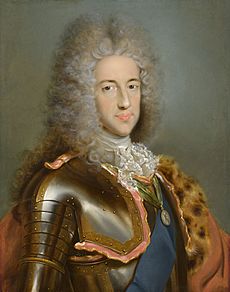
Queen Mary wore mourning clothes for the rest of her life. Her first act as regent was to share a statement about James Francis Edward's claims to the throne. It was mostly ignored in England. In Scotland, some lords sent Lord Belhaven to Saint-Germain. He tried to convince Mary to let James Francis Edward go to Scotland. He also wanted him to become Protestant. Belhaven said this would help him become king when William died.
Mary did not agree. A compromise was reached: if James Francis Edward became king, he would limit Catholic priests in England. He would also promise not to interfere with the Church of England. In return, the Scottish lords would try to block the Hanoverian family from inheriting the Scottish throne.
When William died in 1702, Lord Lovat declared support for James Francis Edward in Inverness. Lovat then went to Mary and asked her to let her son come to Scotland. Lovat planned to raise an army of 15,000 soldiers to take the throne for James Francis Edward. Mary refused to let her son go. The uprising failed. Mary's regency ended when her son turned 16.
Later Life
Mary had wanted to become a nun when she was younger. She found peace at the Convent of the Visitations, Chaillot, near Paris. She became friends with Louise de La Vallière. Mary and her daughter often stayed there for long periods in the summer.
In 1711, Mary learned that her son, James Francis Edward, would lose Louis XIV's support. He would also have to leave France as part of a peace treaty. The next year, James Francis Edward was expelled. Then, her daughter Louise Mary died of smallpox. Mary was very upset. Her friend Madame de Maintenon said Mary was "a model of desolation."
Without her family, Queen Mary lived the rest of her life in poverty. She could not travel because she could not afford new horses. Mary died from cancer on 7 May 1718. Her French friends remembered her fondly. Three of them called her a "saint." Mary was buried in Chaillot among the nuns she had befriended.
Issue
| Name | Birth | Death | Notes |
|---|---|---|---|
| Unnamed child | March or May 1674 | stillbirth | |
| Catherine Laura | 10 January 1675 | 3 October 1675 | died of convulsions. |
| Unnamed child | October 1675 | stillbirth | |
| Isabel (or Isabella) | 28 August 1676 | 2 or 4 March 1681 | buried in Westminster Abbey on 4 March (Old Style) as "The Lady Isabella, daughter to the Duke of York" |
| Charles, Duke of Cambridge | 7 November 1677 | 12 December 1677 | died of smallpox |
| Elizabeth | c. 1678 | ||
| Unnamed child | February 1681 | stillbirth | |
| Charlotte Maria | 16 August 1682 | 16 October 1682 | died of convulsions and buried in Westminster Abbey on 8 October (Old Style) as "The Lady Charlotte-Marie, daughter to the Duke of York" |
| Unnamed child | October 1683 | stillbirth | |
| Unnamed child | May 1684 | stillbirth | |
| James, Prince of Wales "the Old Pretender" | 10 June 1688 | 1 January 1766 | married 1719, Clementina Sobieska; had issue |
| Louisa Maria Teresa | 28 June 1692 | 18 April 1712 | died of smallpox |
Images for kids
-
Mary of Modena in 1685, by Willem Wissing.
-
Queen Mary with her son, James Francis Edward Stuart, by Benedetto Gennari the Younger.
-
Mary II of England in a painting by Sir Peter Lely.
See also
 In Spanish: María de Módena para niños
In Spanish: María de Módena para niños


